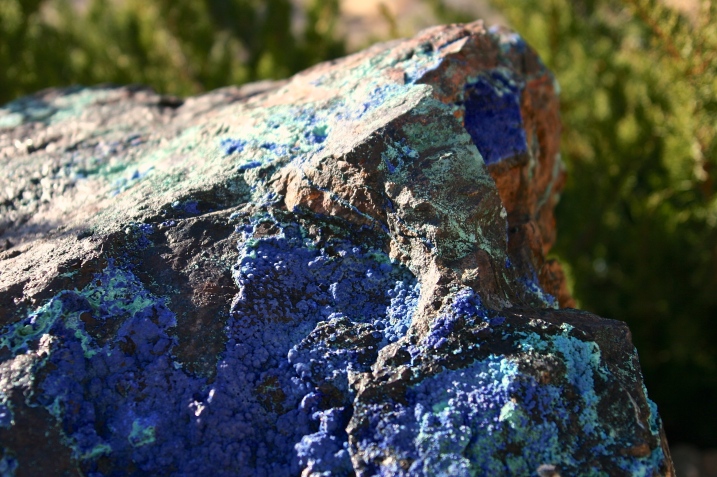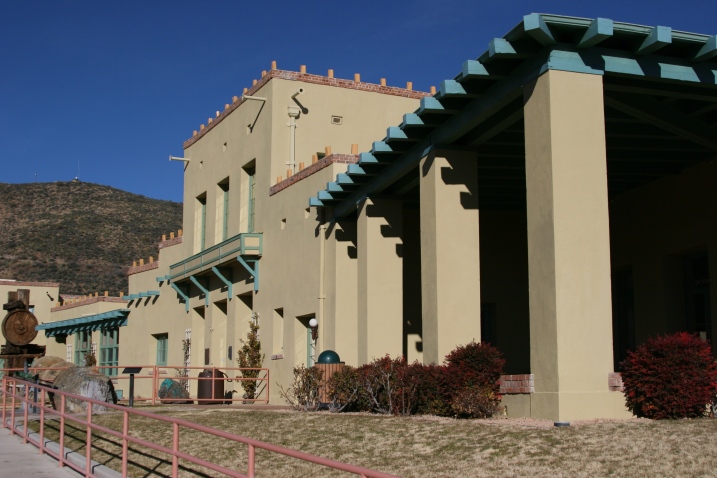Legendary Jerome
Last week Kelly’s mom and her husband offered Kelly and me various suggestions in and around the Sedona area – places we might want to explore while we are here. One such place was Jerome … which they described as a former mining encampment that has reinvented itself into a neat little town with interesting shops.
To be honest, base upon that description I wasn’t quite sold on the idea. Nonetheless, Kelly did a bit more internet research of her own and she was intrigued. Since the town is only about 20 minutes drive from our campground, we decided it was worth further exploration and ventured off to see things with our own eyes … and Wednesday, Lilly tagged along and the three of us spent a few hours wandering the town.
This place is awesome. We loved it.
To fully appreciate why this town is such a gem, a bit of history is in order…
Jerome’s modern history began in 1876 when three lone prospectors staked claims on what proved to be crazy-rich copper deposits. Fairly quickly word spread and soon thereafter every Tom, Dick, & Harry arrived onto the scene, desperately seeking and dreaming of their own rags-to-riches turnaround.
In 1883 the first legitimate mining corporation was formed. Well funded, the United Verde Copper Company bought Jerome into the big leagues of the US mining scene. With this growth, Jerome experienced a swell in population, wealth, and debauchery … along with devastating amounts of destruction due to rampant fires.
Ever the survivor, Jerome would not surrender – its mines easily surfacing vast quantities of money with which to rebuild itself. Finally, in 1912, an East Coast fat-cat named James S. Douglas brought real “east coast money” to the scene and essentially bought-out the town’s mining claims. With deep pockets and a first-rate rolodex, Douglas secured other investors and infused serious cash and infrastructure into his operation (which he renamed Little Daisy Mine) and scaled the situation to the tune of nearly $1 billion (yes, billion) in revenue during his reign as the “Copper King”. Pack burros, mules-drawn freight wagons and horses were replaced by steam engines, autos and trucks … all of which grew mining capacities, expanding beyond copper, to unearth additional gold, silver, lead, zinc, azurite, and malachite deposits.
Douglas’s mines literally printed money. He and his investors were swimming in riches.

The Douglas mansion
As Jerome’s mining output was exploding by orders of magnitude, so to did the population. By the late 1920’s, over 15,000 people – across 20 nationalities – resided in the mining camp. Not surprisingly, as the population swelled, so to did the cosmopolitan day-to-day life … and wealth and debauchery … and the fires.
Eventually local leaders saw fit to hire a police force and also bring religion into the mix. In the end, nothing really changed. Despite the addition of many churches and jail cells, the bootlegging, saloons, and prostitutes continued to flourish. Keep in mind all of this was happening literally on the side of a 30-degree mountain.
Eventually, the great depression and its suffocating grasp slowed the wheels of commerce and the once almighty Jerome fell onto very hard times. The “Copper King” was dealt a crushing blow. The boom became bust.
From what I can tell, the town sputtered for decades. As the population dipped below 100 residents, and on the cusp of drowning, Jerome was thrown a life buoy…
Similar to many places across the country, the 60’s brought artists, hippies, and others of the “counter-culture” movement to Jerome. Quickly, they settled and began selling their artisan wares. These initially unwelcome long-haired undesirables attracted buyers … and as the saying goes – the rest is history.
Today, Jerome is afforded protection as a National Historic Monument, but mainly is a tourist town and affords people with excess cash a nice place to have their second home.
It’s also one bad-ass place, steeped in rich history.
Wandering the streets, remnants of destruction are everywhere. Everything is old, but interlaced with new … a workers dormitory has been converted into a private residence, Madelena’s House (ie- brothel) is now an artist gallery, the Senate Saloon is now a fashion salon, the mining company hospital is now a hotel. The list of old-to-new transformation throughout Jerome is endless. 45-years of richly colorful history affords this place all the ingredients of a must see location. Given the vast network of mining tunnels (nearly 90 miles in total) directly beneath, it’s amazing that the town hasn’t collapsed upon itself.
Get there before it does. **
** Although not for lack of trying. For example – in 1930, following an underground blast, one jail’s foundation failed, allowing it to slide 225 feet down the mountainside. Later – in true bad-ass spirit – a bulldozer drug it from the middle of the street to where it sits today, safely away from potential traffic harm.



















Best travel post I have ever read on Jerome! The tourist board should hire you. I am sold and now really want to visit Jerome. Great info and cool photos.
Thanks Amanda! The place really is cool … blog posts nearly write themselves. And … I’m sure once you and Tim visit your posting will be far more historically descriptive than was mine. 🙂
Hope you and Tim are enjoying Anza-Borrego. _db